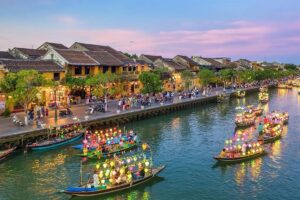1. Overview
Vietnam is a beautiful country with a rich culture, long history, and diverse natural landscapes. Coming to Vietnam, you have the opportunity to admire the unique and majestic natural landscapes and explore the ancient and rustic culture combined with a modern and dynamic lifestyle.
This Vietnam Itinerary 7 Days will take you to experience the Central and Northern regions of Vietnam, where many ancient landmarks are concentrated, along with breathtaking natural landscapes and the richest culture. From sparkling Da Nang to ancient Hoi An and Hue to Ninh Binh and Quang Binh with many UNESCO heritages, and finally the capital Hanoi preserving many cultural values, you certainly cannot miss a moment to enjoy the beauty of Vietnam.

Explore Hoi An Ancient Town – UNESCO World Heritage, The Most Beautiful Ancient City in Vietnam. (Source: internet)
2. Ideal time to travel to Vietnam
Each region of Vietnam has a different ideal time to travel. You can refer to our suggestions below to choose a suitable trip for yourself.
- Northern region (Hanoi, Ha Long): From September to November (autumn) or from March to May (spring) is the ideal time with cool, pleasant weather.
- Central region (Hoi An): From February to April is the most beautiful with light sunshine and little rain.
- Southern region (Ho Chi Minh City, Mekong Delta): From December to April (dry season) is the most ideal time, avoid the rainy season.
3. How to get to Vietnam
By air: The main international airports are Noi Bai Airport (Hanoi), Da Nang Airport (Da Nang) and Tan Son Nhat Airport (Ho Chi Minh City). There are many international and domestic airlines operating flights here.
Domestic travel: Airplanes are the optimal choice for traveling between major cities (Hanoi – Da Nang, Da Nang – Ho Chi Minh City) to save time. In addition, you can use trains and buses for shorter distances or to experience the scenery.

Vietnam Airlines – a popular choice when traveling to Vietnam. (Source: internet)
4. How to move in Vietnam
Currently, transportation in Vietnam is very developed. You can travel by plane, train within the country. Or if you choose to buy a tour from a travel company, they will often take you by bus.
In Hanoi and Ho Chi Minh City, there are also metro systems traveling in the central areas. Besides, car and motorbike services are also very popular and common.
Some hotels and homestays also have motorbike rental services if you want to experience. Rental prices range from 3.0 – 7.0 USD per day.
5. Where to stay for the Vietnam Itinerary 7 Days?
With Vietnam Itinerary 7 Days, it is best to focus on one area (North, Central, or South) to avoid spending too much time traveling and fully enjoy the destinations you have chosen. For the best experience, rent a hotel or homestay in the central area, convenient for traveling and with many sightseeing, dining, and entertainment services.
6. The most detailed suggested Vietnam itinerary 7 days for your perfect one-week journey ( Da Nang – Hoi An – Hue – Quang Bình – Ninh Bình – Hanoi)
6.1. Day 1: Explore vibrant Da Nang
6.1.1. Discover and have fun at Ba Na Hills
Ba Na Hills is a tourist area located on the top of Chua Mountain, 30 km from the center of Da Nang, 1,487 m above sea level. This place stands out with spectacular scenery, unique architecture, and attractive entertainment areas.
- The cable car holds many world records: Visitors will experience the modern cable car system, the longest in the world, providing panoramic views of the majestic mountains, forests, clouds and sky.
- Golden Bridge: The new symbol of Ba Na Hills, famous for its unique architecture supported by giant hands, attracting millions of visitors to check in.
- Fantasy Park: The largest indoor amusement park in Vietnam with hundreds of diverse games, suitable for all ages, from gentle games to thrilling games. Spiritual works: Such as Linh Ung Ba Na Pagoda, Linh Chua Linh Tu Temple, Linh Phong Zen Monastery, etc, bring a peaceful and serene space.

Golden Bridge Da Nang – Tourism symbol on top of Ba Na Hills
6.1.2. Visit Marble Mountains and Non Nuoc Village
Marble Mountains (Ngu Hanh Son), situated just 10 kilometers from Da Nang. This captivating complex consists of five limestone and marble hills, each named after one of the five elements: Kim (metal), Thuy (water), Moc (wood), Hoa (fire), and Tho (earth). Visit Xa Loi Tower, Linh Ung Pagoda 1, Tang Chon Cave, Van Thong Cave, Huyen Khong Cave, Vong Giang Dai, and Tam Thai Pagoda.
The Non Nuoc Stone Carving Village – This historic craft village, with traditions spanning over 300 years, is where you can witness skilled artisans transforming raw stone into exquisite sculptures, jewelry, and household items.
6.1.3. Check in with iconic bridges.
When coming to Da Nang, you cannot miss the Dragon Bridge—a vibrant symbol of the city, famous for its fire and water spraying on Saturday and Sunday nights. Nearby is the Han River Bridge—the only rotating bridge in Vietnam, creating a path for large ships at midnight.
In addition, Da Nang is also famous for other unique bridges such as Tran Thi Ly Bridge with an impressive cable-stayed design, Thuan Phuoc Bridge—the longest suspension bridge in Vietnam—and Love Bridge, a romantic check-in point on the Han River.
6.2. Day 2: Immerse yourself in an ancient Hoi An
Hoi An is a UNESCO World Heritage ancient town in central Vietnam, notable for its ancient architecture, multicultural fusion, delicious cuisine, and entertainment activities. It’s a must-visit destination in your Vietnam itinerary 7 days.
6.2.1. Visit iconic architectural works
Take time to explore unique structures such as the Japanese Covered Bridge (a symbol of Hoi An with unique Japanese architecture spanning a small creek), the Phuc Kien and Quang Trieu Assembly Halls with their splendid Chinese architecture and interesting historical stories, or hundreds of years old ancient houses such as the Phung Hung and Tan Ky ancient houses. Each street corner and each house has its own beauty, telling the story of the golden age of a bustling commercial port.
6.2.2. Explore Hoi An cuisine
Enjoy a bowl of Cao Lau noodles with chewy noodles and fragrant char siu; a bowl of Quang noodles with rich flavors; soft white banh bao – banh vac (also known as “white roses”); or the famous Hoi An chicken rice. Don’t forget to try the famous Phuong bread, praised by many tourists as one of the best sandwiches in the world.

Cao Lau Hoi An – The culinary quintessence of the Old Town. (Source: internet)
6.2.3. Experience sitting on a boat and releasing lanterns on the Hoai River
When the ancient town lights up, the Hoai River becomes the stage for a magical light show. Sitting on a small wooden boat, gliding gently on the peaceful river, you will be able to admire the whole of Hoi An sparkling under the lantern light.
6.3. Day 3: Looking for a peaceful and charming Hue
Saying goodbye to Hoi An, we will go to the ancient capital of Hue – a sacred and ancient land, where the golden vestiges of the last feudal dynasty of Vietnam are still preserved.
6.3.1. Immerse yourself in the antiquity of Hue Imperial City
The Hue Imperial City was the political and cultural heart of Vietnam under the Nguyen Dynasty (1802–1945) and remains a remarkable architectural heritage. Explore iconic sites like Ngo Mon Gate, Thai Hoa Palace, and The To Temple. Don’t miss the royal court music at Duyet Thi Duong, try on traditional costumes for photos, or stroll through ancient halls to feel the serene atmosphere of this former royal capital.

Tourists wearing traditional costumes take photos in front of the gate of Hue Imperial City. (Source: internet)
6.3.2. Visiting the tombs of the Nguyen Dynasty
No trip to Hue is complete without exploring the royal tombs of the Nguyen Kings—masterpieces of architecture that reflect each king’s personality and worldview. Nestled in poetic natural settings, these tombs offer deep cultural and historical insight.
Admire the East-West fusion of Khai Dinh Tomb, the majestic harmony with nature at Minh Mang Tomb, or the serene, romantic space of Tu Duc Tomb. Each tomb tells its own story through delicate carvings, lotus ponds, and peaceful green gardens, blending solemnity with nature.
6.3.3. Listening to Hue folk songs on the Perfume River
A must-try cultural experience in your Vietnam itinerary 7 days is enjoying Hue folk songs on a dragon boat along the Perfume River. As night falls, you’ll relax to the gentle blend of folk and royal melodies for about 50 minutes in a peaceful, poetic setting.
Many tours also include lantern floating on the river – a serene and meaningful activity. Ticket prices range from 3.5–6 USD/person for group tours, with private boat options available at higher rates.
6.4. Day 4: Multi-sensory experience in Quang Binh
6.4.1. Explore Phong Nha Cave, Paradise Cave
Quang Binh is home to two world-renowned cave wonders: Phong Nha Cave and Paradise Cave, offering unforgettable exploration experiences.
Phong Nha Cave, known as “Thien Nam De Nhat Dong”, features the world’s longest underground river, where visitors can cruise through majestic stalactites and admire nature’s mysterious creations.
Paradise Cave impresses with its grandeur and vast scale. A long wooden walkway allows easy access to admire shimmering stalactites in various shapes, creating a magnificent, fairy-tale-like landscape.

Admire the eye-catching stalactites in Phong Nha Cave. (Source: internet)
6.4.2. Experience adventure activities at Hang En, Song Chay – Hang Toi
Hang En, the world’s third-largest cave, offers a thrilling 2-day-1-night trekking and camping adventure. Visitors can marvel at its massive dome, swim in a natural lake, and watch thousands of swallows flying overhead.
Meanwhile, Chay River – Dark Cave is perfect for both adventure and relaxation. Challenge yourself with a 400m zipline across the river, explore the cave with its unique natural mud bath, or enjoy kayaking on the emerald-green waters amid the untouched beauty of Quang Binh’s mountains and forests.
6.4.3. Relax at Nhat Le Beach
Nhat Le Beach is one of the most attractive destinations in Quang Binh, standing out with its wild and peaceful beauty. In addition to swimming and relaxing in the golden sunshine, visitors can also participate in many exciting water sports activities such as paragliding, jet skiing, kayaking, or simply strolling along the beach to watch the beautiful sunrise or sunset, enjoy the fresh air and the sound of waves.
6.5. Day 5: Come to mysterious Ninh Binh
6.5.1. Visiting the Temples of King Dinh and King Le
The Temples of King Dinh Tien Hoang and King Le Dai Hanh are particularly important historical relics, located in Tay Hoa Lu Ward, Hoa Lu City, Ninh Binh Province. These two temples were built on the foundation of the old palace, worshiping two kings with great contributions in the history of Vietnam in the 10th century.
Coming here, visitors will admire the delicate dragon and phoenix sculptures, the monolithic stone dragon beds and majestic shrines. The temple complex is not only a place to commemorate the achievements of the kings but also a historical and cultural space, helping visitors understand more deeply a heroic period of the Vietnamese people.
6.5.2. Let yourself go on Sao Khe River in Trang An
Taking a boat in Trang An is an experience not to be missed in your Vietnam 7 – day itinerary, taking you on a journey to discover the majestic beauty of Trang An Scenic Landscape Complex, a UNESCO World Heritage Site.
You’ll sit on bamboo boats rowed by locals, gliding through peaceful waterways. Trang An offers several routes (typically 3–4), lasting 1.5 to 3.5 hours, each revealing a unique part of “Ha Long on land”.

Boats glide gently on the Sao Khe River in Trang An, Ninh Binh, Vietnam. (Source: internet)
6.5.3. Visiting Bai Dinh Pagoda
Bai Dinh Pagoda is a must-visit spiritual site in Ninh Binh, known as the largest pagoda complex in Southeast Asia with grand architecture and scenic surroundings. It features both ancient and modern structures, holding many records like the largest bronze Buddha and bell, and the longest Arhat corridor. Visitors can walk or take electric cars to explore the shrines, admire Buddha statues, and enjoy the serene atmosphere.
6.6. Day 6: Return to the capital Hanoi, a thousand years of culture
6.6.1. Visiting the Ho Chi Minh Mausoleum and the Presidential Palace Relics
When coming to Hanoi, visitors will have a special opportunity to visit the Ho Chi Minh Mausoleum, the resting place of the great leader of the Vietnamese people. This is a majestic and solemn architectural work, expressing the deep gratitude of the Vietnamese people to Uncle Ho.
Right next to the Mausoleum is the Presidential Palace Relics, an important historical relic complex including Uncle Ho’s stilt house, fish pond, and the Presidential Palace. Visitors will admire Uncle Ho’s simple living and working space, from the rustic stilt house to the familiar fish pond, helping you clearly visualize his frugal lifestyle and closeness to nature.

Ho Chi Minh Mausoleum, the resting place of the great leader of the Vietnamese people. (Source: internet)
6.6.2. Experience a Hanoi city tour
Visit famous ancient sites such as West Lake, Tran Quoc Pagoda, Hoan Kiem Lake, Ngoc Son Temple, The Huc Bridge. Additionally, you can also visit the Ho Chi Minh Museum or Hoa Lo Prison, which are also popular choices for city tours.
6.6.3. Strolling around Hanoi Old Quarter
You’ll wander through a maze of narrow streets named after traditional crafts like Hang Bac, Hang Gai, or Hang Ma — echoing the charm of old Hanoi. With its French colonial architecture and vibrant daily life, the Old Quarter offers a vivid glimpse into the city’s rich history and culture.
From the lively Dong Xuan Market to quiet temples tucked in alleyways, every corner tells a story. It’s also a place where ancient traditions blend seamlessly with modern urban life — a must-visit for those seeking the true soul of Hanoi.
6.7. Day 7: Goodbye Hanoi, see you again Vietnam
Before ending the Vietnam itinerary 7 days, don’t forget to enjoy Hanoi cuisine. Hanoi is not only famous for its beautiful scenery and long history but also a culinary paradise that attracts every tourist. You will easily find dishes that have become trademarks such as Hanoi pho with clear, fragrant broth and soft pho noodles.
Don’t forget to try bun cha, a dish that once captivated former President Obama, with fragrant grilled pork patties served with fresh vermicelli and sweet and sour dipping sauce. In addition, bun dau mam tom, nem ran, La Vong fish cake, or snacks such as Ho Tay shrimp cakes, egg coffee, Trang Tien ice cream are also culinary experiences you cannot miss when visiting the capital.

Pho Hanoi- The Quintessence of Vietnamese Cuisine. (Source: internet)
7. Conclusion
This Vietnam itinerary 7 days offers a compact yet rich journey through the country’s top cultural and natural highlights. To make the most of your journey, consider traveling with Asia Luxury Travel, a trusted local expert specializing in curated, high-quality Vietnam tours designed for comfort, authenticity, and unforgettable memories.
8. Contact :
Phone: +84 965 721 426
Email: sales@asialuxurytravels.com
Website: https://asialuxurytravels.com/
Address: No. 9, Alley 31/7, Phan Dinh Giot Street, Thanh Xuan, Hanoi





